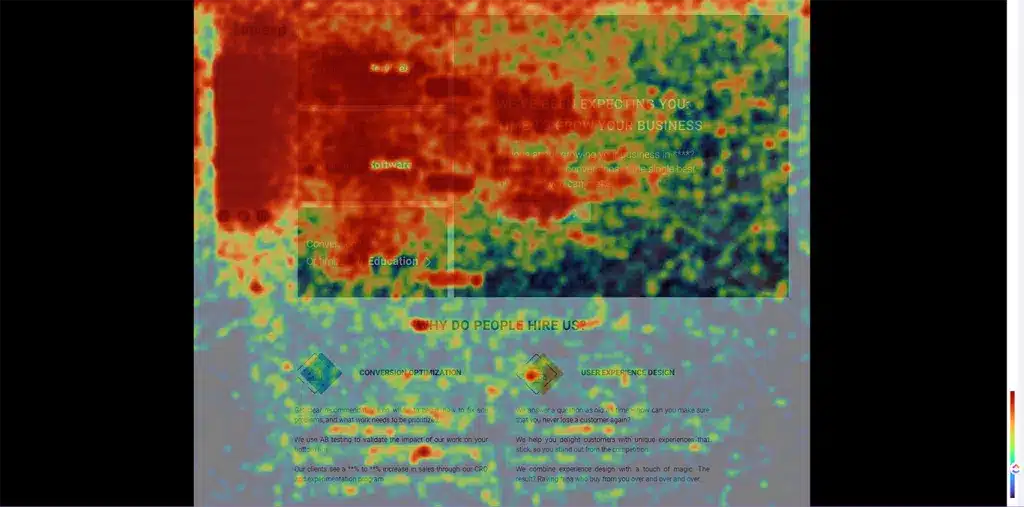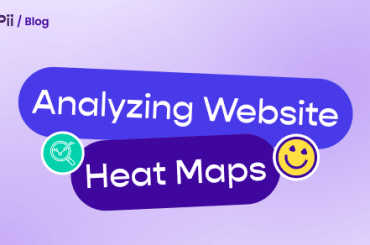Heatmaps are fantastic tools for understanding customer behavior on your website or app.
You can use this information to see whether or not people are clicking on certain parts of your website or not, and use that insight to improve your design and user experience.
A heatmap is a graphical representation of the data you get from a mouse tracker on your website or app.

In other words, you can see where people are clicking on your site.
This information can help you determine if certain parts of your design are more effective than others, which gives you an idea of how to make it better in order to increase conversions. Heatmaps are often used by advertisers when developing an advertising campaign because they show what areas need more attention. You can use this information for a variety of reasons, such as optimizing the user-friendliness of a product.
What is a heatmap?

A heatmap is a graphical representation showing where visitors click on your website. You can use this information to see how people are reacting to certain parts of your site or change the way your design is set up so it’s more user-friendly for them.
You can use this information to see whether or not people are clicking on certain parts of your website or not, and use that insight to improve your design and user experience.
This information can help you optimize your site so that people are converting at their highest rates without getting frustrated trying to find something on the page.
It’s also important to remember that heatmaps can reveal what sections need more attention when it comes to advertising campaigns.
You’ll be able to see which sections need more focus because people are clicking on them more than others.
When developing an advertising campaign, advertisers use heatmaps to see how people are reacting to the ads. You’ll be able to see which areas need more attention and use that insight to improve your design and user experience.
7 Underrated Benefits Of Heatmaps

Here are 7 underrated benefits of heatmaps:
1 . Check Clicks On Your Landing Page
Using heatmaps will let you know which parts of any given page or section on your site get the most attention from visitors.
This offers great insight into what you should keep and what could be changed to improve conversions.
For example, if you were using an email sign-up page and the majority of users didn’t engage with it, then you know your CTA needs to be improved.
2 . Get To Know Visitors Better
Heatmaps allow you to get inside your visitors’ heads better.
Instead of wondering about their actions when they’re on your site, next time just check out the heatmap to see where they’re clicking.
When you find that very few people are clicking in certain areas, then this could mean that they have no idea what’s there, or perhaps it looks too much like advertisement spam for them.
Either way, knowing about these problems can help lead to a more effective design for your website.
3 . Optimize Advertising Campaigns
Heatmaps are a powerful tool for helping you to optimize your advertising campaigns.
When you know where people click the most, then this allows you to have an idea of what to emphasize in future advertisements.
You can use this data from heatmaps to determine whether or not certain ads should be working better based on where they’re getting clicked on the page.
Yes, it’s possible to track where people are clicking all over specific pages, but that adds up very quickly and isn’t as effective as if you only need the one heatmap that tells you how well your overall campaign is going.
4 . Get Better Results From FigPii
Heatmaps can help any website owner improve their results from FigPii.
This is an eCommerce CRO tool that lets you see where people click on your site, and it can be used as a powerful tool for developing your website.
With the help of heatmaps, you’ll always know what’s working for you and what should be changed to make even more conversions and higher profits.
5 . Tracking Behavior On Mobile Devices
If you use mobile devices like tablets or smartphones to navigate through your site, then using heatmaps will allow for a great way to track behavior from those particular platforms.
Heatmaps aren’t limited to just desktops or laptops which is why they’re so useful when it comes to making big changes to any campaign.
Every customer interaction with your brand needs to be taken into consideration because every single one counts.
6 . Track Hotspots
Some people may not realize that you can create hotspots on your heatmaps. Hotspots are kind of like circles or bubbles that show you which areas get the most attention when it comes to clicking on certain parts of your site. You can also change these clickable areas into something else, so maybe clicking something will bring up advertisements instead. Whatever you decide, hotspots are a great way to organize data in order to make future decisions about what’s working best for your website’s design.
7 . Get Feedback On Your Design
Heatmaps provide great feedback when it comes to updating your website’s current design. This is because they’re able to give you an idea of how users react to pages and other aspects of your site before any of the changes are actually made. Just logging in to your analytics can give you some great insight into how your customers are reacting to certain things, but heatmaps still provide more than that regarding user behavior.
How useful are heatmaps?

Heatmaps are useful for many different aspects of your business, including optimizing the user-friendliness of a product, and understanding customer behavior on your website or app.
Here are some examples of how companies used heatmaps effectively:
– Spotify used a heatmap to see where users were most likely to play songs and then changed their layout design accordingly.
– BuzzFeed used it so they could develop engaging and shareable posts and infographics.
The more detailed the report is, the better analysis you’ll get from your heatmaps.
Try using a variety of heatmaps as well as testing various ones before making a decision on which one works best for you.
Additionally, make sure that you keep track of your heatmap reports so you can identify trends over time.
It’s also important to remember that heatmaps can reveal what sections need more attention.
You’ll be able to see which sections need more focus because people are clicking on them more than others.
Heatmaps are used to help develop websites in order to make sure people have an easy time navigating through everything.
They also provide great feedback when you want to check out how effective your advertising is for a certain campaign.
They’re able to give you an idea of how users react to pages and other aspects before any changes are made.
Heatmaps are very useful for many different purposes, which is why they should be considered when optimizing your website’s design.



